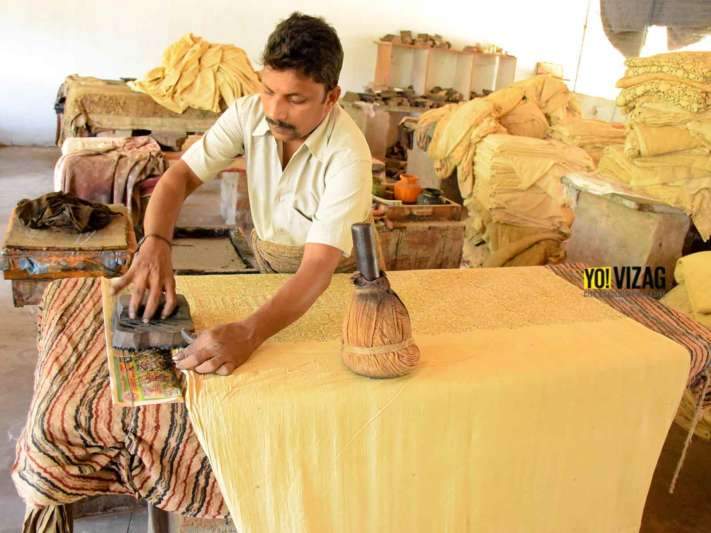

Block printing
The age-old technique of block printing is a heritage art form, popular in Andhra Pradesh. Having originated in Machalipatnam and Pedana, today there are pockets across the East Godavari district which practice this art of block printing. One such place is in the village of Aryavatam. Half an hour drive from Kakinada takes one to this village, where a few have taken up this work. We reach the house of Suryanarayana, where a portion of their house has been converted into a shop, and bales of printed cloth lie in the store. Kalamkari saris vie for attention along with printed borders, diwan sets and also dress materials. After feasting our eyes on this colourful collection, we drive down to the unit where the block printing actually happens.
As you enter, the first sight that catches the eye, is the length of cloth which has been left to dry on the ground. A huge room with tin sheets lies beyond, and this is where the magic happens. A few people stand at their workstations, deeply involved in the work they’re doing. Hundreds of blocks engraved with fine designs lie in a corner. ‘Each design that we print consists of a set of blocks’, shares Suryanarayana, whose family has been doing this work since the past forty years. Dealing exclusively with vegetable dyes, he shares that once a particular design is chosen, the cloth is treated with dung and karakkai so as to enable it to absorb the dye. In a design with multiple colours, blacks and reds are printed first. The cloth is washed in a running stream of water, and the other colours are then printed on it.
The workstation comprises of a rectangular bench on which the artisans place the cloth. The block is then periodically dipped in the dyes and the motif printed on to the fabric. The process is completely done by hand, and the artisan stands for the long period of time to perfectly print the design. Natural dyes made from pomegranate, turmeric and other substances from the forests give the kalamkari print a unique look. The original process on a length of cloth takes a month for completion, and because the work of colour extraction isn’t easy, vegetable dyed Kalamkari tends to cost higher.
The Aryavatam center has hundreds of blocks, which have been made over the years. Nature inspired motifs are seen to be stacked along with modern geometric designs. Suryanarayana tells us however, that times are tough for this art form, as workers today are hard to come by. ‘People don’t want to take this up anymore’, he shares, telling of how they want to go for more lucrative options. Also while these enjoy a better market in other states of India, local markets still have a comparatively lower demand.
With the next generation still reluctant to take on this line of work, the future of Kalamkari is uncertain. One can however hope that the growing demand for its colourful designs and appeal will keep this fascinating art alive.
In response to the terror attack in Pahalgam on 22 April 2025 and the Indian…
The Government of Andhra Pradesh is setting the stage for a record-breaking event on June…
In a major push toward sustainable public transport, EKA Mobility has secured a contract to…
There are a variety of new movie and web series releases today on our favourite…
The survival trope in movies and television shows is one of the popular genres, attracting…
For months now, the mayor’s chair in Visakhapatnam has been making headlines. From no-confidence motions…
Leave a Comment